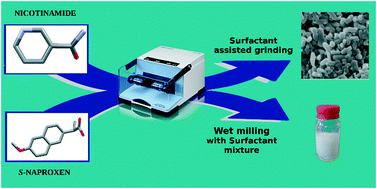Pharmaceutical nanococrystal synthesis: a novel grinding approach†
Abstract
Pharmaceutical nanococrystals are solid forms with potential to increment the oral bioavailability of drugs belonging to class II of the biopharmaceutical classification system through the conjunction of the advantages of cocrystal formation and particle size reduction. Herein, results regarding the investigation of in situ synthesis of these nanoparticles are reported, using (2 : 1) (S)-naproxen–nicotinamide as a cocrystal model, through grinding assisted by minimal amounts of solutions of non-ionic surfactants or by PEG 6000, as stabilizers. Additionally, studies regarding a top-down wet milling method were also carried out. Results identify the nature and concentration of the stabilizer and, for nanodispersions, the choice of dispersion medium, as major challenges in the synthesis of nanococrystals. Solid forms were characterized by attenuated total reflectance-infrared spectroscopy, differential scanning calorimetry and X-ray powder diffraction. Particle size was determined by scanning electron microscopy and laser diffraction, proving the successful obtention of a nanopowder (surfactant-assisted grinding, SAG) and a nanodispersion (wet milling) stabilized by a mixture of Span® 85 and Tween® 85. The one-step synthesis of nanococrystals through SAG proved to be a greener and efficient way to obtain these nanoparticles, paving the way for an important evolution in cocrystal nanosizing.



 Please wait while we load your content...
Please wait while we load your content...